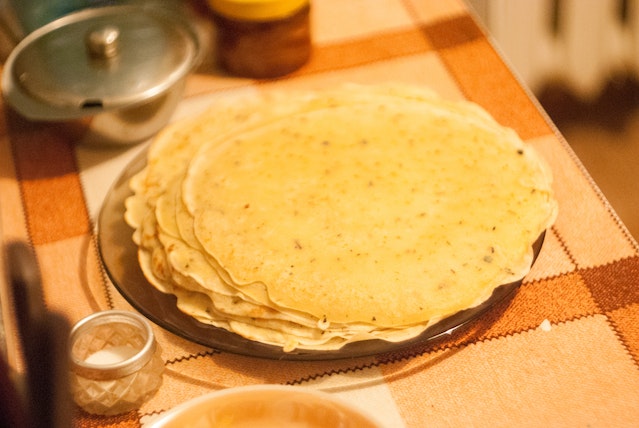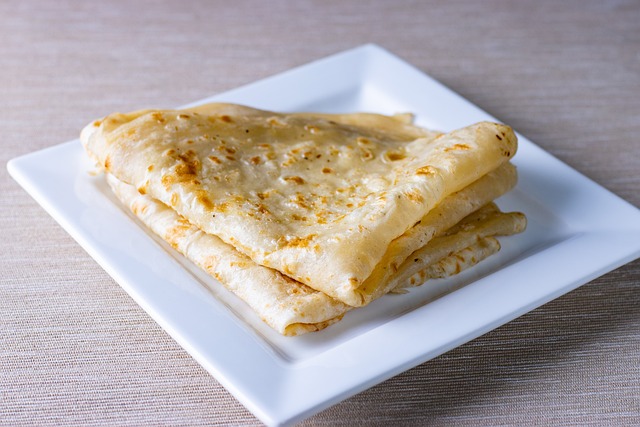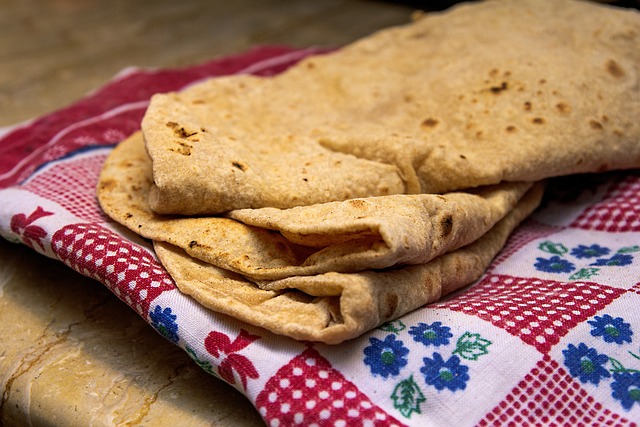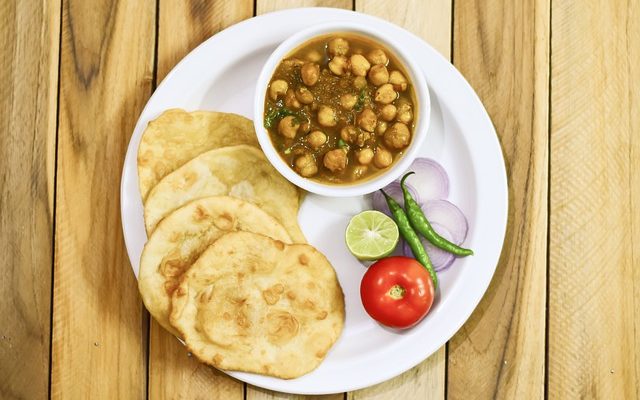When it comes to making your favorite dishes, there are many ingredients and types of bread that can work well. Two main contenders in this game are tortillas and roti, both considered popular staples all over the world. But when you look more closely between Tortilla and Roti, their differences come into play – from texture and flavor to health benefits and nutrition facts. So what makes each one unique? Let’s take a dive into the difference between Tortilla vs Roti to get a better understanding of how they stack up against each other!
Table of Contents
What Is Tortilla?
Tortillas are a flatbread made from maize or wheat flour and have been a staple of Mexican cuisine for centuries. Traditionally, tortillas are served with a variety of fillings such as beans, cheese, vegetables, and meats. They can be eaten either as a main course or as an accompaniment to other dishes. In addition to being popular in Mexico, tortillas are now enjoyed throughout the world.
The ingredients used in making tortillas vary depending on the region, but typically include ground corn/maize (or maseca), water or broth, baking powder for added fluffiness, salt for flavor enhancement and oil for softness. The dough is then shaped into round discs before being cooked on a comal or griddle. Listo-brand tortillas are pre-cooked and ready to use, making them a convenient option for those short on time.
Tortillas can be eaten soft or left to cool and become crisp. They can also be lightly fried in oil to form a ‘totopo’ which is used as a crunchy topping for dishes such as enchiladas. Additionally, they can be cut into triangles and deep-fried to make popular snacks known as chips or nachos.
Whether enjoyed plain, filled with tasty ingredients or transformed into party snacks, it’s no wonder the humble tortilla has found its way onto dinner tables around the world!

How are Tortillas Made?
Tortillas are a delicious and versatile Mexican staple, used in tacos, burritos and more. Making your own tortillas can be a fun cooking project, and it’s easier than you think! All you need is some simple ingredients and the right tools to make your very own homemade tortillas.
Ingredients:
– 2 cups of all-purpose flour
– 1 teaspoon baking powder
– ¾ teaspoon salt
– 5 tablespoons lard or vegetable shortening
– Approximately ⅔ cup hot water
Instructions:
– In a large bowl, mix together the flour, baking powder, and salt until combined.
– Cut in the lard or shortening until it resembles coarse meal.
– Slowly add the hot water, mixing with a spoon or your hands until it forms into a dough.
– Knead lightly for 8 to 10 minutes, then place in an oiled bowl and cover – let the dough rest for at least 1 hour before using.
– Heat up a skillet or griddle over medium-high heat.
– Divide the dough into small balls (approximately golf ball size) and roll each one out as thinly as possible on a lightly floured surface – they should be thin enough to see through!
– Once the skillet is hot, cook each tortilla for about 30 seconds per side (until golden brown) and place on a plate covered with a clean towel to keep warm.
– Enjoy your delicious homemade tortillas!
Making your own tortillas is a fun and easy cooking project that the whole family can enjoy. All you need are some simple ingredients, the right tools, and a little bit of time and patience. With these tips, you’ll be well on your way to making delicious homemade tortillas that will rival any restaurant’s!
What Is Roti?
Roti, also known as chapati or roti prata, is an unleavened flatbread made from whole wheat flour that is a staple in many cultures around the world. A traditional Indian dish, roti has been prepared by families for centuries and often served alongside curries and other vegetarian dishes. It is usually cooked on a griddle or tava and can be served hot with ghee (clarified butter) or yogurt for added flavor.
Listing all of the health benefits associated with roti would be too lengthy to include here, but suffice it to say that its high nutritional content makes it one of the healthiest breads available. Whether you’re looking to add variety to your diet or switch up how you get your daily dose of whole grains, roti is an excellent choice.
In addition to its health benefits, roti also offers versatility and convenience. It’s easy to prepare and can be served as a side dish or main course depending on the ingredients used. Roti is often eaten with both sweet and savory dishes, making it suitable for breakfast, lunch, dinner, or even snacks. You can also customize it by adding various ingredients such as herbs, spices, nuts, fruits, vegetables and more so that you can enjoy a different flavor combination every time—the possibilities are truly endless! So if you’re looking for a nutritious bread option that is flavorful and versatile enough to use in all sorts of dishes, then roti is the way to go.

How Are Roti Made?
The ingredients necessary to make roti are usually staples found in most pantries. These include whole wheat flour, water, oil, and salt. For added flavor, some people may opt for ghee or yogurt in their dough recipe. In terms of utensils and equipment, a rolling pin and griddle are necessary, as well as a large bowl to mix the dough.
To get started on making your own roti at home, first combine the wheat flour with a pinch of salt in a large mixing bowl. Next add small amounts of oil while simultaneously pouring water over the mixture until you reach desired consistency- you want it to be soft but not too sticky. Knead the dough until smooth – this could take up to 10 minutes.
Once the dough is ready, roll it into a large ball and cover in plastic wrap so that it doesn’t dry out. Then, break off small pieces of the dough and roll each one into a thin circle using your rolling pin. Heat up a griddle over medium-high heat and cook each roti for about 30 seconds on either side, making sure to press down with your spatula to ensure even cooking throughout. Voila! You have now successfully made your own homemade roti. Enjoy!
Tortilla Vs Roti Comparison: Face To Face
Tortillas and roti are both popular flatbreads that are staples in many countries. While they may look similar at first glance, there are important differences between the two. In a side-by-side comparison of tortilla vs roti, here are some key points to consider:
– Texture: Roti has a softer texture than tortillas, while tortillas usually have a chewier consistency.
– Ingredients: Tortillas typically contain flour (often wheat), water, and lard or vegetable shortening; other ingredients may include salt and baking powder. Roti is traditionally made with whole wheat flour and oil, but it may also use all-purpose flour for an alternate texture.
– Preparation: Tortillas are usually cooked on a flat griddle, while roti is cooked over an open flame.
– Nutrition: Both tortillas and roti are rich sources of carbohydrates but differ in their nutritional makeup. Roti contains more fibers than tortillas and is also lower in fat; tortillas tend to have higher amounts of sodium and saturated fat.
– Flavor: Roti has a nuttier flavor than tortillas, which have a milder taste.
– Uses: Tortilla wraps are often used as vehicles for tacos or burritos, while roti can be served with curries or other dishes to add texture and flavor.
Overall, both tortilla vs roti offer unique flavors and textures that can contribute to a variety of dishes. Depending on the desired outcome, one may be more suitable than the other. Consider the different points highlighted above when making your decision.
>>> You might also like:
Chilaquiles Vs Huevos Rancheros
Best Bread Maker Consumer Reports
FAQs About Tortilla Vs Roti
Tortilla and roti are both flatbreads that can be found in various cultures around the world. While their names may differ, these two popular breads have some similarities. Here is a list of commonly asked questions about tortilla vs roti:
What Are The Differences Between Tortillas And Roti?
The main difference is that tortillas are traditionally made with corn or wheat flour, while roti is usually made with whole-wheat flour. Tortillas tend to be thinner than rotis and have a soft texture, while rotis can be thicker and have a more chewy texture. Additionally, tortillas typically have a mild flavor, while rotis often contain spices like cumin or coriander.
Can Both Tortillas And Roti Be Used For Wraps?
Yes, both tortillas and rotis can be used as wraps. However, due to the difference in texture, a tortilla wrap will typically have a softer, more pliable texture than a roti wrap. Additionally, if you are looking for an authentic Indian-style wrap or want to add additional spices to your wrap, then using a roti might be the better choice.
How Do I Reheat Either Type Of Bread?
Tortillas can be reheated in the microwave or oven. For microwaving, place the tortilla on top of a damp paper towel and heat for 30-45 seconds until warm. For oven reheating, place the tortillas on a baking sheet and heat in a preheated oven at 350 degrees Fahrenheit for about 5 minutes. Roti can also be reheated using the microwave or oven method. However, roti will often become hard if reheated in the microwave, so it is best to reheat in the oven if possible. Simply place the roti on a baking sheet and heat in a preheated oven at 350 degrees Fahrenheit for about 5 minutes until warm.
What Are Some Popular Dishes That Use Either Type Of Bread?
There are many popular dishes that use tortillas, such as tacos, burritos, quesadillas, and enchiladas. For roti, some popular dishes include parathas, chapatis, and various types of Indian-style flatbreads.
Are Either Type Of Bread Healthy?
Both tortillas and rotis can be part of a healthy diet as long as they are made with whole grain flour. Whole wheat tortillas and rotis are higher in fiber and other nutrients than refined varieties. Additionally, adding fresh vegetables or lean proteins to the wraps can help make them even healthier.
Can I Use Roti Instead Of Tortilla?
Roti can be a great substitute for tortillas depending on the dish you’re preparing. Roti is an Indian flatbread made with whole wheat flour and water, and it’s typically cooked on a griddle or in a skillet. It has a slightly firmer texture than tortillas, but it can still be used similarly in many dishes. Here are some of the ways that you can use roti as a replacement for tortillas:
– Wraps: Roti makes an excellent wrap base – just spread your favorite fillings onto one side, fold over the edges, and enjoy!
– Quesadillas: Instead of using two tortillas to make quesadillas, try making them with just one piece of roti.
– Burritos: Roti can be used to make burritos in much the same way you would use a tortilla – just fill it up and roll it tight!
– Tacos: Fold a piece of roti in half and place your desired taco fillings inside for an easy and delicious meal.
– Pizza crusts: You can also use roti as a pizza crust – top it with your favorite toppings and bake until everything is nice and crisp.
Roti is an incredibly versatile ingredient that can easily take the place of tortillas in many dishes, so don’t be afraid to get creative and experiment! With these ideas, you’ll be able to enjoy all of your favorite dishes in a whole new way.

Can You Eat Tortilla Without Cooking?
It is possible to eat a tortilla without cooking it, but it is generally not recommended. This is because uncooked tortillas are usually quite dry and difficult to chew. Additionally, raw tortillas may contain bacteria such as E. coli and Salmonella, which can make you sick if consumed. Furthermore, raw flour has been linked to potential health risks, including an increased risk of developing diabetes and gastrointestinal upset.
If you decide to eat uncooked tortillas, it is important to purchase them from a reputable supplier and follow safe storage practices. For example, store the tortillas in a sealed package or container at room temperature until they are ready to consume. Additionally, make sure that you thoroughly wash your hands before and after handling uncooked tortillas. Ultimately, for optimal safety and taste, it is best to cook tortillas prior to consuming them. Heating or steaming the tortillas will make them soft and easy to chew, as well as reduce the risk of foodborne illness.
Do Tortillas Need To Be Refrigerated?
Tortillas do not require refrigeration. Many people choose to store their tortillas in the refrigerator for a longer shelf life, however this is not necessary for preserving the quality and flavor of the product. To keep tortillas fresh without refrigeration, simply keep them tightly sealed in a plastic bag or air-tight container at room temperature.
How Long Can Tortillas Last Without Food?
Tortillas can last for a long time without food, as they are typically made of durable ingredients. However, the exact length of time that tortillas can last will depend on the specific recipe and ingredients used. For example, whole wheat tortillas made with fresh ingredients may only last for a few days, while those made with preservatives may last for up to a month or more. Additionally, storing tortillas in the refrigerator will help them stay fresh longer.
To extend the shelf life of your tortillas even further, you can freeze them and defrost as needed. Store-bought packaged tortillas may have an expiration date printed on the package, so be sure to check that before using them. Regardless of how long they last without food though, it is important to store tortillas properly and take any necessary precautions to keep them from going bad prematurely. Proper storage and use can ensure that your tortillas remain safe and delicious for as long as possible!
What Happens If You Fry A Tortilla?
Frying a tortilla is a great way to make crunchy, delicious chips and tacos. But what happens when you fry the tortilla? Does it become something else entirely?
When you fry a tortilla, it changes its composition slightly. The heat from the oil causes the moisture in the dough to evaporate, transforming it into an airier version of itself. The result is something between a chip and a taco shell with crispness on one side and softness on the other. Depending on how long you fry it for, your fried tortilla can be light and fluffy or super crispy. This versatile ingredient can add texture to salads, soups, and more!
>>> See more: SOFT ROTI | How To Make Super Soft Handmade Roti.
Conclusion
While both tortilla vs roti are delicious, they each have different benefits. Tortillas are great forWraps because they’re soft and pliable. Roti is a healthier option because it’s made with whole wheat flour. Ultimately, the choice between tortilla and roti comes down to personal preference. Do you prefer the taste of tortillas or the health benefits of roti? Let us know in the comments below!
Welcome to the Cafe Toscana Restaurant blog! Here you’ll find all the latest news and information about our restaurant, including menu updates, special events, and more. We hope you’ll enjoy reading and please feel free to leave us your feedback!

